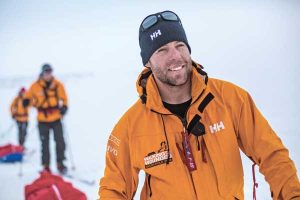Wounded vets prepare for South Pole
By Lookout on Jul 08, 2013 with Comments 0

MCpl Chris Downey and the rest of Team Commonwealth pull pulks during expedition training in Iceland.
Teams of wounded veterans from the U.K., the U.S. and the Commonwealth (Australia and Canada) are embarking upon on one of the most high profile and toughest expeditions of modern times – walking to the geographic South Pole.
Walking with the Wounded – South Pole Allied Challenge is an extreme undertaking for 11 people that will take 16 days and cover 330 kilometres in -35C, all to show the world the extraordinary courage and determination of wounded military members.
MCpl Chris Downey and Cpl Alexandre Beaudin D’Anjou will represent Soldier On and the Canadian Armed Forces as a beacon of hope and inspiration for other injured veterans. Both were wounded during their tour in Afghanistan.
“I want to prove to other wounded servicemen that you can still do great things as a wounded soldier,” said 31-year-old combat engineer Cpl D’Anjou. “I know a lot of guys who are wounded and on the couch, and I want to tell them live their lives. We only have this time to take advantage of life, and if you have a goal you should go for it.”
Following extensive training, teams will fly to Antarctica in November. They aim to reach the South Pole around Dec. 17.
“For me it’s about doing this with 11 other wounded soldiers in the hopes that together we will inspire thousands of injured soldiers to start living the life they should despite the limitations they may have,” said 31-year-old air weapons systems technician and EOD operator, MCpl Chris Downey.
Each team has four members, and the Canadian soldiers have teamed up with two Aussies.
In Cold Lake, Alberta, MCpl Downey has been hauling a sled weighing 70 kilograms about 13 kilometres to work and back three days a week through town. When the snow melted he switched to pulling tires.
“I am currently using the ‘Insanity Workout’ six days a week pulling two tires three times a week and weight training three times a week,” he said. “Initially there were a lot of big eyes wondering what is that guy doing, especially when I was crossing the main lights on my way home. Recently, my endeavour and training has been announced on the local radio station and the town now knows,” he said.
It’s a similar story for Cpl D’Anjou in Quebec. He’s pouring all of his energy into the preparation and training. His four children are talking up their father at school.
“My oldest son is seven and he is talking about what his dad is doing with his friends at school. A webpage will follow us with GPS co-ordinates so they can follow our progress on a map and know where we are. When I walk I think about my family, and because I have chronic pain it reminds me of everything that happened in Afghanistan as well.”
In March, the teams got a taste of what they’ll experience in Antarctica when they embarked on a five week expedition that covered a 60 kilometre glacier in Iceland.
“I was most surprised that everything is white in every direction,” said Cpl D’Anjou. “It made me realize the most difficult challenge will be that I am alone. There are no trees and you can’t talk to anyone as it’s too noisy with the wind, so you are doing two or three hours straight with just time to think – a lot of time to think.”
For MCpl Downey, the mere thought of going to Iceland for training excited him. “Every time I have been involved with any activity with wounded soldiers it’s hard to describe the connection and feeling I get. There is a common ground we share. You can be 100 per cent honest with your feelings, emotions, and injuries and nobody judges you. I find that part alone is so incredible.
“For me, part of the inspiration to be part of this unique adventure is the people involved. Ivan from the U.S. is completely blind and seeing him skiing is incredible. Duncan from the U.K. team is on prosthetics with both legs and when you look at him it’s unbelievable.
I was asked by a reporter what the most beautiful thing I saw in Iceland was, and my response to that question was seeing Ivan pulling a sled while skiing. To me that trumps everything.”
During the Iceland training teams learned how to use the stoves, ski equipment and how to cook and set up camp in extreme conditions.
“Our guides have 20 years plus experience in polar expeditions to the South and North Poles. They also taught us how to rescue someone from a crevasse,” said Cpl D’Anjou. “It was the first time they trained a military team and they liked the way we worked together to get every task done.”
In the South Pole they will walk 20 kilometres a day in order to complete the challenge in 16 days.
“If I had never been hurt overseas I wouldn’t be doing this,” says MCpl Downey. “Out of something horrible came this once-in-a-lifetime opportunity. I see reaching the pole as one of the few ways I can thank the people who supported me, from the medic on the ground, doctors, surgeons, and family and friends. I also keep a promise to PO2 Douglas Craig Blake who was killed in the same blast. I made a promise to him that I wouldn’t waste a single minute of my life because I believe he absorbed the majority of the blast that enabled me to survive.”
Editor’s note: A documentary is being made about this expedition and live feeds, videos and photos will be available at http://walkingwiththewounded.org.uk/southpole2013/.
-Shelley Lipke, Staff Writer
Filed Under: Top Stories
About the Author:





